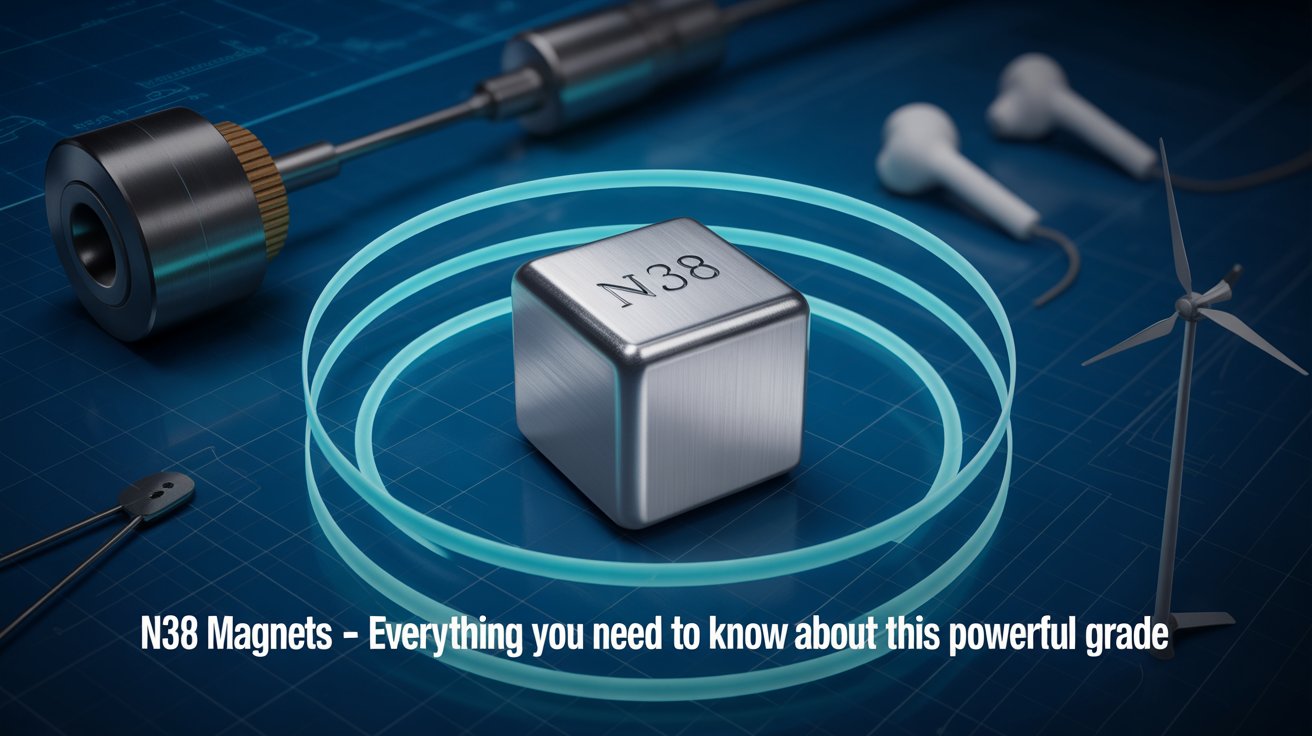N38 Magnets – Everything You Need to Know About This Powerful Grade
In the world of magnets, particularly rare earth magnets, the variety of grades and specifications can be daunting. Among these, N38 magnets stand out as a popular choice, offering a compelling balance of strength, versatility, and cost-effectiveness. This blog post will delve into everything you need to know about N38 magnets, from their fundamental properties and applications to their advantages and limitations. Whether you’re an engineer, designer, hobbyist, or simply curious, understanding N38 magnets can unlock new possibilities in your projects.
What Does “N38” Actually Mean?
Before diving deeper, let’s decode the “N38” designation. This alphanumeric grade provides crucial information about the magnet’s characteristics:
- “N”: This letter indicates that the magnet is a Neodymium magnet (more accurately, a Neodymium-Iron-Boron or NdFeB magnet). Neodymium magnets are the strongest type of permanent magnets commercially available.
- “38”: This number represents the Maximum Energy Product of the magnet, expressed in MegaGauss-Oersteds (MGOe). The (BH)max value is a primary indicator of a magnet’s strength. A higher number generally signifies a stronger magnet. For N38 magnets, this value typically ranges from 36 to 39 MGOe (or 287-310 kJ/m³).
Therefore, an N38 magnet is a neodymium magnet with a specific range of magnetic strength. It’s a mid-range grade within the broader N35 to N52 spectrum commonly available, offering a significant step up in power from lower grades like N35, while being more accessible than the highest grades like N52.
Key Properties
Maximum Energy Product: ~38 MGOe
Remanence (Br): 12.2 – 12.6 kGs
Coercivity (Hc): ≥10.8 kOe
Operating Temp: Up to 80°C standard (can vary with coating)
Composition of N38 Magnets
N38 magnets are made from:
Neodymium (Nd): The main rare earth element
Iron (Fe): Provides structural stability
Boron (B): Enhances magnetic alignment
Trace elements like Dysprosium (Dy) or Praseodymium (Pr) for temperature stability
Magnetization Options
N38 magnets can be magnetized in various directions depending on the shape:
Axially magnetized (most common for discs/cylinders)
Diametrically magnetized (for ring shapes)
Multi-pole magnetization (for special applications)
Applications of N38 Magnets
Electronics
Speakers & Headphones
Microphones
Hard Disk Drives
Motors & Generators
Electric vehicles (EVs)
Wind turbines
Servo motors
Industrial Applications
Magnetic separators
Holding and lifting tools
Magnetic sensors
Consumer Products
DIY tools
Magnetic toys
Phone holders and magnetic mounts
N38 vs Other Grades
| Grade | Energy Product (MGOe) | Strength | Cost | Common Use |
|---|---|---|---|---|
| N35 | ~35 | Low | Low | Budget use |
| N38 | ~38 | Medium | Mid | Balanced use |
| N42 | ~42 | High | Mid | Consumer electronics |
| N52 | ~52 | Very High | High | Specialized machinery |
Disadvantages and Considerations
Lower heat resistance (standard N38 operates up to 80°C)
Brittle nature: Can chip or crack under mechanical stress
Corrosion risk: Must be coated with nickel, zinc, or epoxy for protection
Coatings and Finishes
To protect N38 magnets, the following coatings are commonly used:
Nickel-Copper-Nickel (Ni-Cu-Ni) – Most common and durable
Zinc – Good corrosion resistance
Epoxy – Best for humid or salt-rich environments
Gold or Silver – Rare, used in medical or specialty products
Handling and Safety Tips
Avoid snapping two magnets together — can cause shattering
Keep away from electronics and credit cards
Wear gloves to prevent pinching injuries
Customization Options
Many manufacturers offer:
Custom magnet sizes and shapes
Tailored coatings based on environment
Laser engraving or branded markings
Sourcing and Buying Tips
Verify grade (N38) and coating type before purchase
Look for suppliers offering ISO-certified quality
For large volumes, request samples before bulk ordering
Who Uses N38 Magnets?
Automotive companies
Electronics manufacturers
Renewable energy sectors
Medical equipment producers
DIY enthusiasts and crafter
N38 neodymium magnets offer a powerful and versatile solution for a multitude of applications. Their excellent strength-to-size ratio, good magnetic properties, and relative cost-effectiveness make them a go-to choice for engineers, designers, and hobbyists alike. While it’s important to be aware of their limitations, such as brittleness and temperature sensitivity, and to handle them with care, the benefits they provide often far outweigh these considerations. By understanding the “N38” designation and its associated properties, you can confidently select and utilize these remarkable magnets to bring your innovative ideas to life. Always ensure you source your magnets from reputable suppliers to guarantee quality and consistent performance.
FAQs
Q1: Are N38 magnets strong?
Yes. N38 magnets provide strong magnetic force suitable for most industrial and consumer applications, though not as strong as N52.
Q2: Can N38 magnets be used outdoors?
Yes, if properly coated (e.g., epoxy or nickel), N38 magnets can withstand moderate outdoor conditions.
Q3: How long do N38 magnets last?
N38 magnets can retain their magnetism for 10+ years under proper storage and use conditions.






